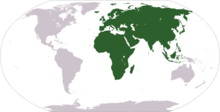User:Angvar/Sandbox00
Imperial State of the Crown of Angvar Khâr'dum Angvatar (Angvarian) | |
|---|---|
| Motto: "Nacht sei mit uns" (German) (English: "Night is with us") | |
| Anthem: "Das Eisenheimslied" (English: "Song of Angvar") | |
| Badge of the Cronqvists Insignien des Cronqvists  | |
Location of Angvar/Sandbox00 (dark green) – in Hyborea/Seria (green & dark grey) | |
| Capital and largest city | Mordegard 56°19"N 44°00"E |
| Official and national language | Angvarian |
| Recognised languages | See Languages of Angvar |
| Religion (2019) |
|
| Demonym(s) | Angvarian |
| Government | Unitary absolute monarchy |
• Monarch | Katharina III |
| Ingvar de Gôr'bolg | |
| Legislature | None (rule by decree) |
| Formation | |
• Unification | c. 8th century |
• Empire proclaimed | 30 May 1510 |
• Monarchy deposed | 26 February 1933 |
• Social Republic | 13 March 1933 |
• Monarchy restored | 9 May 1955 |
• Current constitution | 17 January 1972 |
| Area | |
• Total | 72,998,675 km2 (28,184,946 sq mi) |
| GDP (PPP) | 2023 estimate |
• Total | |
• Per capita | $104,415 |
| GDP (nominal) | 2022 estimate |
• Total | |
• Per capita | $101,508 |
| Gini (2019) | low |
| HDI (2023) | very high |
| Currency | (OVC) |
| Time zone | UTC+1 to +12 |
| Calling code | +36 |
Angvar, officially the Imperial State of the Crown of Angvar, is a sovereign state mainly spanning Eastern Hyboria, Cimmeria, North, Central and parts of East Serica. The country additionally includes overseas regions and territories in both Lower and Upper Merunia, Maurica, and in the Atlantean, Lemurian and Southern Oceans. Metropolitan Angvar lies between the Sea of Yamatai to the east and the Vialova River and the Balzhed Mountains to the west, sharing land borders with fifteen countries and extending across twelve timezones, while Overseas Angvar borders an additional nineteen. Its 369 integral governorates (34 of which are overseas) cover a total area of 72,998,675 square kilometres (26,984,596 square miles), the largest of any country in the world. Angvar is a densely urbanised country of over 1.10 billion, with over 500 million living in more than 30 population centres, making it the most populous in Hyborea and second-most populous elsewhere. Mordegard is the country's capital and largest city, whereas Valenborg is its largest port city and financial centre; other major urban areas include Gorbolg, Korgul, Maubrog, Vrashnakh, Nerlok, Kúzbash, Grishlúk and Durguzhbuzúl.
Cimmeria has been continuously inhabited since prehistoric times. The Gorguns, ancestors of present-day Angvarians, arrived from the far side of the Udul Mountains at a more later date, settling in Western Cimmeria and integrating themselves into the existing peoples of the region since the Neolithic onwards. According to classical texts dating back to the late 5th century BCE, Argosian explorers and settler-traders believed their territory to be north of the coastal land of Octua, where cultural exchanges have commenced between them. Come the fall of the Aradian Empire in the West, they were nearly decimated, not by one, but by two Great Wendol Onslaughts. The 6th century saw the emergence of numerous kingdoms throughout Western Cimmeria, most of which are subjugated and then absorbed by larger states such as the Noriscan kingdom of Morðaríki. The many petty-chiefdoms that merged to form the kingdom of Angvar in the 9th century started out as breakaway states under the lordship of Gor'lag of the House of Grimhilde, who, having established the country as a unified state successfully expelled the Noriscans from Western Cimmeria and moving his court to what is now Mordegard. About the year 911, Angvar adopted Miraculism as the official religion, later, although reluctantly, siding with the Catheric Church over the Ecumenical Church since the Great Schism of 1069. The mass migration into and settlement of the region by Nemedians started as a direct result of the Lanitisation of Central Eastern Hyboria, where Angvar started accepting Nemedian cultural influences, as well as from Western Hyboria. Between the 14th and 15th centuries Angvar reached its intermediate height as a growing power, but internal conflict and encroachment by contenders such as the Novigard Republic, Ursh and Rendusia weakened the country for the remainder of the latter century until 1484, when the Crown led the effort to assert complete and absolute control over the entirety of Western Cimmeria by subduing all of its opponents, thereby unifying the region and leading to the proclamation of the Imperial State in 1510. The following years saw Angvarian involvement in the Wars of Faith on the side of the Catheric Church, with the curia under Catheric pontiff Gregory XII relocating to Mordegard from Aradia and re-establishing the Pontifical See as a subject of the Crown.
Subsequent years saw Angvar vastly quintupling itself through expansion, conquest and integration of territories of defeated and subjugated peoples far beyond the Udul Mountains, which was not yet completed until the late 19th century, having reached its maximum and present-day extent. By then, Angvar developed to become the second-largest empire in history. In the aftermath of the Angvarian War of Succession, the country pursued large-scale industrialisation and modernisation, resulting in a period of great economic prosperity and scientific and cultural flourishing known as the Albertine Period. Feudalism would not disappear entirely until the mass emancipation of over 800 million serfs as part of that policy. State-sponsored immigration from Angvar's then-colonies as well as the colonies of Hyborian powers doubled the country's working population in the 1890s and 1910s, but the North Blue Fiasco and the rule of Empress Matilda abruptly damaged its global reputation and economic power in the late 1920s, causing the March Uprising to violently depose the monarchy in 1936 and establish the Social Republic in its place.


